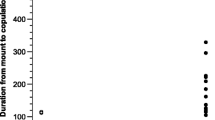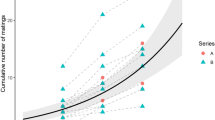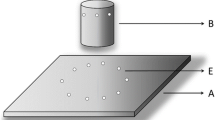Summary
Female milkweed leaf beetles (Labidomera clivicollis clivicollis) frequently mate with more than one male, and pairs form mating associations which last for up to 42 h in the field. I tested the hypothesis that males remaining with females for long periods of time benefit by numerically overwhelming the sperm of their competitors. Male L.c.clivicollis copulated intermittently with females throughout an 11 hour period in the laboratory. When virgin females were allowed a single copulation, 94.3% of the sperm they received were located in the spermatheca immediately afterward. Males were not sperm-depleted, for they had large numbers of sperm available after one copulation (mean=230,000±43,200); the maximal number of sperm a male transferred to a female in 24 h was 30,500. There was a positive linear relationship between the number of sperm transferred and time up to 24 h after mounting (r 2=0.178, P<0.003). These data suggest that males transfer increasing numbers of sperm throughout a 24-h-period. Mating duration was the most important determinant of paternity when females were placed with one male for 24 h and another male for 6 hours. Females whose first matings were longer showed first male sperm predominance (as determined by starch-gel electrophoresis), while females whose second matings were longer showed last male sperm predominance. In view of these data, it is puzzling that males do not inseminate with large numbers of sperm immediately after mounting the female. It is possible that female refractory behaviors make insemination difficult and favor prolonged mating by male milkweed leaf beetles.
Similar content being viewed by others
References
Alcock JA (1976) Courtship and mating in Hippomelas planicosta (Coleoptera: Buprestidae). Coleopt Bull 30:343–348
Altmann J (1984) Observational sampling methods for insect behavioral ecology. Fla Entomol 67:50–56
Eickwort KR (1977) Population dynamics of a relatively rare species of milkweed beetle (Labidomera clivicollis). Ecology 58:527–538
Eisner TE (1965) Defensive spray of a phasmid insect. Science 148:966–968
Gromko MH, Gilbert DG, Richmond RC (1984) Sperm transfer and use in the multiple mating system of Drosophila. In Smith RL (ed) Sperm competition and the evolution of animal mating systems. Academic Press, New York, pp 372–427
Hagedorn HH, Turner S, Hagedorn EA, Pontecorvo D, Greenbaum P, Pfeiffer D, Wheelock G, Flanagan T (1977) Postemergence growth of the ovarian follicles of Aedes aegypti. J Insect Physiol 23:203–206
Hughes AL (1981) Differential male mating success in the white spotted sawyer Monochamus scutellatus (Coleoptera: Cerambycidae). Ann Entomol Soc Am 74:180–184
Johnson LK (1982) Sexual selection in a brentid weevil. Evolution 36:251–262
Johnson LK (1983) Reproductive behavior of Claeoderes bivittata (Coleoptera: Brentidae). Psyche 90:135–149
Kirkendall LR (1984) Long copulations and post-copulatory ‘escort’ behaviour in the locust leaf miner, Odontota dorsalis (Coleoptera: Chrysomelidae). J Nat Hist 18:905–919
Lanier DL, Estep DQ, Dewsbury DA (1979) Role of prolonged copulatory behavior in facilitating reproductive success in a competitive mating situation in laboratory rats. J Comp Physiol Psychol 93:781–792
Lindgren B (1968) Statistical theory. Macmillan New York, pp 241–252
May B, Wright JE, Stoneking M (1979) Joint segregation of biochemical loci in Salmonidae: results from experiments with Salvelinus and review of the literature on other species. J Fisheries Res Board Can 36:1114–1128
McCauley DE, O'Donnell R (1984) The effect of multiple mating on genetic relatedness in larval aggregations of the imported willow leaf beetle (Plagiodera versicolora Coleoptera: Chrysomelidae). Behav Ecol Sociobiol 15:287–291
McVey ME, Smittle J (1984) Sperm precedence in the dragonfly Erythemis simplicicollis. J Insect Physiol 30:619–628
Oglesby JM, Lanier DL, Dewsbury DA (1981) The role of prolonged copulatory behavior in facilitating reproductive success in male Syrian golden hamsters (Mesocriceta auratus) in a competitive mating situation. Behav Ecol Sociobiol 8:47–54
Page RE Jr, Metcalf RA (1982) Multiple mating, sperm utilization, and social evolution. Am Nat 119:263–281
Parker GA (1970) Sperm competition and its evolutionary consequences in the insects. Biol Rev 45:525–567
Parker GA, Smith JL (1975) Sperm competition and the evolution of the precopulatory phase behavior in Locusta migratoria migratorioides. J Entomol [A] 49:155–171
Schlager G (1960) Sperm precedence in the fertilization of eggs in Tribolium castaneum. Ann Entomol Soc Am 53:557–560
Silberglied RE, Shepherd JG, Dickinson JL (1984) Eunuchs: the role of apyrene sperm in Lepidoptera? Am Nat 123:255–265
Sillen-Tullberg B (1981) Prolonged copulation: a male ‘postcopulatory’ strategy in a promiscuous species, Lygaeus equestris (Heteroptera: Lygaeidae). Behav Ecol Sociobiol 9:283–289
Sivinski J (1983) Predation and sperm competition in the evolution of coupling durations in the stick insect Diaphomera veliei. In: Gwynne DT, Morris GK (eds) Orthopteran Mating Systems. Westview, Boulder, pp 147–162
Smith RL (1979) Repeated copulation and sperm precedence: paternity assurance for a male brooding water bug. Science 205:1029–1031
Waage JK (1979) Adaptive significance of postcopulatory guarding of mates and nonmates by male Calopteryx maculata (Odonata). Behav Ecol Sociobiol 6:147–154
Waage JK (1984) Sperm competition and the evolution of Odonate mating systems. In: Smith RL (ed) Sperm competition and the evolution of animal mating systems. Academic Press, New York, pp 251–290
Walker WF (1980) Sperm utilization strategies in nonsocial insects. Am Nat 115:780–799
Wilcox RS (1984) Male copulatory guarding enhances female foraging success in a water strider. Behav Ecol Sociobiol 15:171–174
Woodhead AP (1985) Sperm mixing in the cockroach Diploptera punctata. Evolution 39:159–164
Author information
Authors and Affiliations
Rights and permissions
About this article
Cite this article
Dickinson, J.L. Prolonged mating in the milkweed leaf beetle Labidomera clivicollis clivicollis (Coleoptera: Chrysomelidae): a test of the “sperm-loading” hypothesis. Behav Ecol Sociobiol 18, 331–338 (1986). https://doi.org/10.1007/BF00299664
Received:
Accepted:
Published:
Issue Date:
DOI: https://doi.org/10.1007/BF00299664




